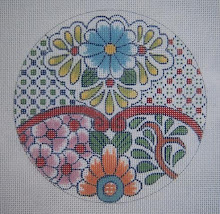 When researching the origins of plaid several years ago, I was not surprised to learn that it originated, of course, in Scotland. I still visualize, however, in pre-history, some ladies weaving grass mats for their homes, and noticing that the different colors of grasses, when they crossed each other in warp and weft, created a definite pattern - and this probably led to further experimentation with plant dyes.
When researching the origins of plaid several years ago, I was not surprised to learn that it originated, of course, in Scotland. I still visualize, however, in pre-history, some ladies weaving grass mats for their homes, and noticing that the different colors of grasses, when they crossed each other in warp and weft, created a definite pattern - and this probably led to further experimentation with plant dyes.Plaid, in it's simplest form - the gingham checks - is one of the first woven fabrics I sought to replicate in needlepoint many years ago. It's just a matter of using a color plus white (in it's simplest form) and a symmetric count - that is, on this one, four threads blue and four white. Where they cross, a third value is produced. (When using two colors instead of the white, a third color is made.
 )
) In the second picture, I used two colors plus white, and a different format. Same number of threads (4) but it looks entirely different from the simple gingham. This illustrates the many many possibilities for re-arrangeing thread counts and colors and creating an endless variety of plaids!
To begin a plaid, the canvas needs to be marked for ease in stitching - and the WARP must be stitched first, as needlepoint canvas is a woven fabric, and the warp of any fabric is the strongest element. I have seen people start stitching across - on the weft, but this is like doing continental stitch on mono canvas - it will warp badly.
You can see on the marked canvas that I have marked the four threads for color only - as this makes it easier to see where to insert the white. Just stitch in basketweave down as far as you want on the four threads vertically - using ONLY the "bumps" of the warp threads. Make the stripes of color and white BEFORE stitching the weft. (which also should be marked at the sides to avoid confusion).
 I really enjoy using this to frame names and monograms - or quotes, and made a door hanger for my first grandson with "crayon" colors - full intensity! The white "background" was reduced to three threads only, and the color stripes are five.
I really enjoy using this to frame names and monograms - or quotes, and made a door hanger for my first grandson with "crayon" colors - full intensity! The white "background" was reduced to three threads only, and the color stripes are five.
Ihad an interesting development several years ago, as I decided one day I needed a very small scale plaid for a patch on a crazy quilt ornament - so I used two threads of each color - and to my surprise, houndstooth check appeared. Happy accident!!

Another happy accident happened when I was stitching the little pink and orange gingham heart, and was bored that day, - deciding to do the weft in beads in the same colors to see what would happen. To my amazement, it looked beaded solid!

There are many many uses for plaids - and I enjoy them so much, as starting to stitch on a bare white canvas is like painting with your needle - and as the plaid emerges, one wants to just keep on going to see what the next repeat is going to look like. It never gets boring. I have done a book on this, which goes into much more detail and shows many more uses for it - but meanwhile, this should give you some ideas to get started.

The next two charts will show the progress of stitches, beginning with the vertical stripes of the plaid worked on the warp threads - the "bumps" when the vertical threads are on top. Then the weft (where the horizontal threads are on top - the "dips") I used blue ink to show what would be white on the blue and white gingham.

The arrows point to the warp threads as they lie on top in the weave.

The second chart illustrates the plaid being formed as the weft is stitched horizontally. Notice where the green crosses the white (blue on this) that a second element of color is formed.
I hope you will use this and enjoy it - and create some new ones of your own. You'll find yourself closely examining clothing on people at the supermarket, and noticing the structure of plaids in upholstery materials - Fascinating!!

Thanks for the great tutorial.
ReplyDeleteYour work is beautiful!
ReplyDeleteThanks a lot for the tutorial, I hope to reach some of your great skills.
Faby